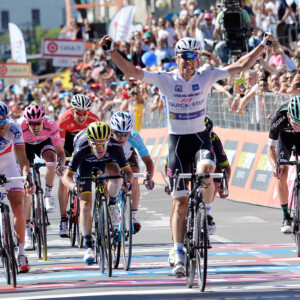Market saturation isn’t the goal for Wheelworks; this four-man team is more concerned with building the perfect wheel and their solid reputation is snowballing as a result.
The cycling lifestyle is a powerful thing. Much more than a hobby or a pastime, bikes become a way of life for those who are drawn in. Bikes shape our lifestyles, our career choices and where we live. This is all true for 35 year old Tristan Thomas; he is the founder of Wheelworks, a boutique wheel builder based in the cycling friendly city of Wellington, New Zealand.
Tristan is a pretty smart cookie. He studied computer science in Canada before moving to New Zealand where he completed a degree in mechanical engineering. After his time at the Wellington Institute of Technology, he was faced with the life shaping choice; earn good money in an engineering career, or take the financially risky route of going full-time with his own custom wheel building business. Well you can guess how that decision played out…
Across New Zealand And Around The World
Now, 11-years down the track, Tristan is still following his heart and Wheelworks is shipping wheels all around New Zealand and across the globe. This isn’t an instant rags to riches success story. Their growth has been steady and they aren’t looking to flood the market with OEM sales. Instead they’re sticking to their core values by creating wheels that are personalised for each and every customer. That in itself isn’t exactly ground breaking but the attention to detail applied during the build process exceeds anything I’ve ever encountered.
Absolute Attention To Detail
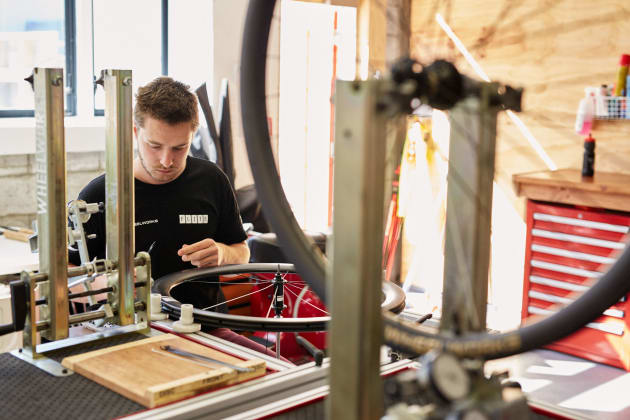
Every part is selected for a specific reason and they don’t just accept the stock wheel components as supplied. For example, every single spoke is cut to length with new thread rolled on to obtain exactly the right spoke length, accurate to 0.1mm. They use DT Swiss spokes as they’ve found they offer the highest level of quality and reliability but then combine them with Wheelsmith nipples; nothing about their wheels is generic and every decision backed by exhaustive research.
To discover more about what makes Wheelworks tick, we had a long chat with Tristan about their unique build process and the direction of modern wheel design.
BA. When you started your own business, why did you choose to focus on wheels?
TT. I’d worked in bike shops for a long time and always enjoyed wheel building. I have always been fascinated by the impact that a good set of wheels can have. Fitting the wrong wheels can turn a good bike into a pretty average one. Of course a nice set of wheels can turn an average bike into a really great one.
I also like the process behind building good wheels. It’s not an art as some people suggest, it is a process and there are a lot of steps involved. Wheel building is all about consistency and accuracy; two things that I enjoy and excel at.
In establishing Wheelworks, I was able to focus on developing the wheel building process, designing tools that assist with each step of the process and create a system that results in extremely consistent high quality wheels. It was something that I found fascination and that I was really into.
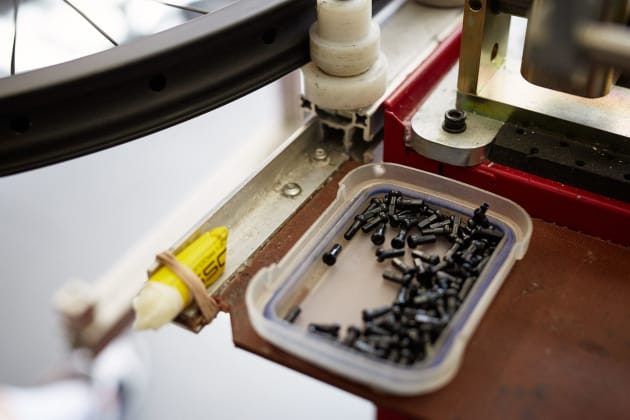
BA. Was there a point where things really took off?
TT. There hasn’t been any single key event; it has just been ongoing word of mouth. We build great wheels and deliver really good customer service. People tell their friends and the business has grown from there.
BA. How many people do you employ?
TT. There are four of us working full-time at the moment. We have two guys building wheels, one full-time on customer service and I do a mix of customer service as well as stock ordering and business management. We’ve also got a part time graphic designer and a part time accountant.
BA. So you don’t get your hands dirty building wheels anymore?
TT. No, it’s pretty rare these days. I will build the occasional pair when we’ve got more wheels to build than hours in the day but the guys have a pretty good handle on that side of things.
BA. How busy is the workshop?
TT. Like every business it goes up and down. It’s extremely rare that we’re quiet and generally ranges between flat-out and busy.

BA. Does everybody at Wheelworks ride?
TT. Yeah for sure. That’s definitely a key to who we are; we need to have cyclists employed.
BA. What makes your wheels unique?
TT. We offer a lifetime guarantee on the build quality of all of our wheels.
There are two ways that you can offer that kind of warranty. You can buy something cheaply and sell it for a high price, then replace the ones that fail using the margin that you made. The alternate approach is to put a huge amount of effort into reducing potential problems, using really high quality components with a major focus on quality control, systems and processes. It may sound boring but the end result is a really consistent, good quality pair of wheels—we chose to go that way.
This approach means it takes much longer to build a set of wheels but the end result speaks for itself. To the best of my knowledge were the only company in the world that offers a lifetime guarantee on wheels and our return rate is infinitesimally small—next to zero.
BA. So how long does it take to build a set of wheels?
TT. From picking the individual components, creating the decals, lacing, truing, tensioning, taking the photos and boxing, it takes around four hours per pair to get them by the front door and ready for pickup. We could cut this in half quite easily if we wanted to but we’d have to compromise on quality or personalisation options, and that’s something that I’m not interested in doing—there’s plenty of people who can do that and I don’t want to be one of them. We want to offer the lifetime guarantee and offer the personalisation options that we’ve got.
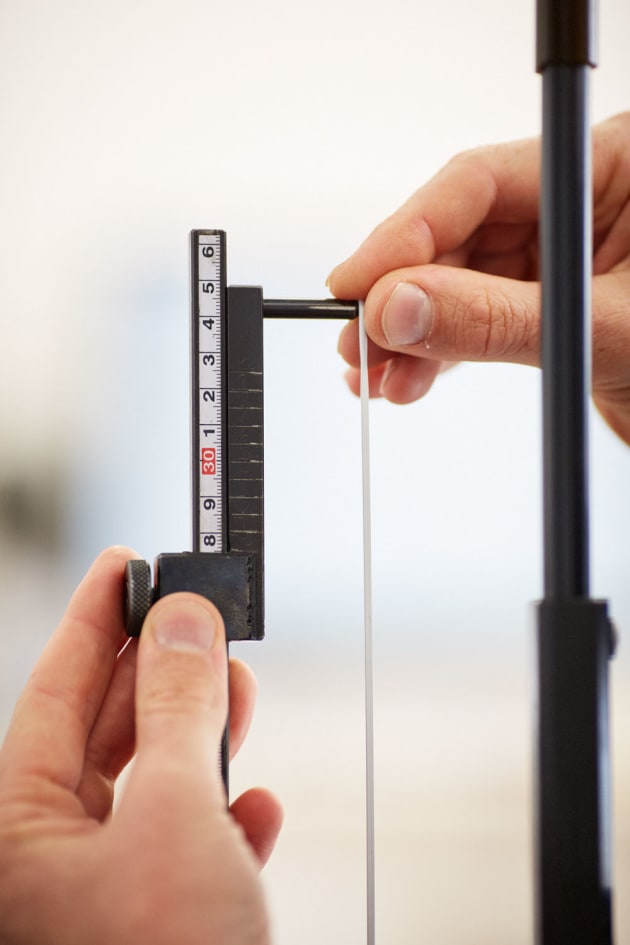
BA. What systems and tools are key to the Wheelworks build process?
TT. There’s no one silver bullet, no one thing that we do that nobody else does that instantly creates a high quality wheel set. It’s more that we look closely at each step within the wheel building process to ensure that every aspect is done in the best possible way and ensuring that it’s repeatable and consistent every single time.
Our two wheel builders are both creatures of habit and extremely fastidious, meticulous people. They’re also very patient with massive attention to detail—they’re really not your normal human beings. Those qualities make for an absolutely great wheel builder.
Most of the tooling is custom made and developed by us. Before the wheels are built, we’ve got some custom software to record all the details for each personalised wheel set. We’ve then got software that’s used to create the decals and they’re CNC cut out from there.
For every wheel we then measure the hubs and rims with custom tools that were designed and developed here. Even within the same brand and model components, there can be small variance in things like the ERD and we take these into account.
We then have some custom software for calculating the spoke length and this takes into account things like spoke stretch under tension. With the drive-side on the rear wheel, each spoke is under around 130kg of tension, so each spoke will grow by about a millimetre under that tension and we take that into account.
Each spoke is then cut to the exact length that’s required – within 0.1mm tolerance – and we roll new thread on using a Japanese-made Morizumi spoke rolling tool. The software also records the exact details for each and every build; spoke length, what grease was used, what prep-steps were done and so on. This way, if we ever had a problem later on or if the owner needed to replace a spoke after having a stick through the wheel, we’ll have all the details on file.
We lace the wheels in a custom built cart that holds everything nice and steady and flat—we’re not building with a wheel leant up against a bench or resting in our lap. The nipples are then set with a custom depth-setting tool to get the threads even and provide a consistent starting point before any tension is added. From there we move onto some German made truing stands. They’re an off-the-shelf item but we’ve heavily customised them to better fit our needs.
Then we’ve got ‘Grimlock’; this is a pneumatic ram that pushes down on the hub to pre-stress a wheel. It’s something that we built and developed and we have dies to suit all different hubs. Grimlock stresses a wheel far beyond what a rider could ever do. We use Grimlock, then re-tension and re-true, then use Grimlock again until the wheel remains straight and holds its tension throughout the process. As a result, there’s no settling or pinging when the wheel is brand new and our wheels will remain true and well tensioned for their natural life.
BA. How much force does it apply to the side of the hub?
TT. Well I can’t tell you that because it’s taken a huge amount of maths, experience and trial and error to get to the number that we’ve settled on.
BA. So this stress doesn’t push things too far and reduce the lifespan in any way?
TT. No, not with the high quality components that we use. It’s well within the safe limits for our DT Swiss spokes and high quality rims but the forces are still a lot higher than what a rider could produce. That said, we have put other wheels through Grimlock which lead to broken spokes and pulled nipples through rims.
BA. Who’s responsible the design of all these specialist tools and the software?
TT. I wrote all the software. I know how to code so everything was written by myself using various API’s; we use a lot of Python and Google Apps Script too.
My background in mechanical engineering and product design means I’ve spent a lot of time in the workshop welding and working with lathes and mills. This has been invaluable with creating some of the one-off tools that we use to maintain consistency in our build process.
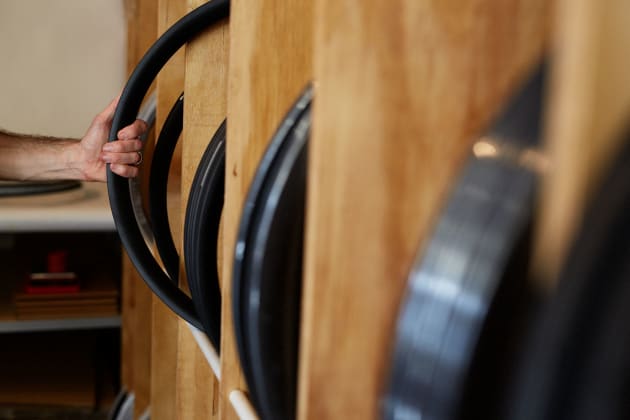
BA. When building wheels for a customer, what factors do you take into account and how do you take these into account with the build?
TT. Rider weight is super important and we need to know what the wheels are going to be used for. Beyond that we’ll want to know what the customer is looking to improve; what do they want to get out of this new wheel set. With that information we can determine the best components for the build.
BA. What would be your most popular build?
TT. Our Maker 35 and 50 would be the most popular rims and for the hubs it would be split in equal thirds between the DT 240, White Industries and our new Dial hubs.
BA. You offer both big brand name Enve rims as well as your own carbon rims (the Maker). How do they stack up against each other in price and performance?
TT. The key with developing our own products is that they have to outperform the ones that we can buy from another brand—I’m not interested in doing second-rate me-too items. If there’s room to improve on something and we have the capacity to do so, then that’s something we’ll look at doing.
With the Maker we’re able to do it about $1,000 cheaper than the Enve and we’re able to put a lifetime warranty behind it. Again I don’t think there’s any other manufacturer who stands behind their carbon wheels like that. We’ve done all our in-house testing with it; impact testing, brake heat testing and we know that it outperforms everything else on the market. Our return and defect rate with the Maker is far less than 1% which is absolutely unheard of.
Enve is a great company to work with; their products are very good and their branding and marketing is extremely strong. It’ll depend on the rider in the end and there are certain use-cases where one rim will suit better than the other. I think the two products – the Enve rims and our Maker line – complement each other really well.
BA. The Maker rims are manufactured for you; how much input did you have with their design?
TT. We worked with an American company that has a huge amount of experience in designing carbon road rims—they’ve been doing it for 25-odd years. I’ve been able to draw upon their knowledge and they know how to engineer a strong nipple bed, they know how to make a really good brake track. I was able to take on the design ideas that I liked and improve upon the aspects that I didn’t like.
We were able to optimise the shape, the width, depth and the channel profile for the tyres and so on. The moulds were then made for us under licence in the US and sent to Taiwan where all the production work is done.
With this, we’ve noticed that the whole concept that USA-made is good and Asian manufacture is second-rate has all but disappeared in the last couple of years. We’ve seen some US made composites that are just terrible and some Chinese made product that’s beautiful; really well thought out, really well manufactured and very high quality. The country of origin has no relevance anymore—it means nothing. You can get crappy products that are made in China and you also get crappy products that come out of the UK, US and Europe.

BA. Can you tell us a little more about your lifetime warranty, what it covers and how it works?
TT. We don’t have any heavy legal documents outlining our warranty—we’re a small company and we are pretty flexible with it. It basically boils down to this; we guarantee that nothing weird is going to happen to your wheels until they’re worn out.
We answer our phones and if anyone has any queries or comments about our warranty, then we’re happy to discuss it. In general we’ll warranty stuff that’s quite grey and really shouldn’t be covered but it happens so infrequently that we don’t need to have lawyer written policies around it.
BA. So what would and wouldn’t you consider to be a warranty issue?
TT. Things like worn out bearings would not be covered, unless they wore out really quickly; bearings are a consumable item. On a rim brake wheel, the brake track is also a consumable item; it’ll take years but it will eventually wear out and that’s not a warranty. Catastrophic crash damage or getting a stick jammed through the spokes won’t be covered either. We do carry spare parts for all our older wheels, so we can repair crash damage if required.
We do guarantee that the wheels won’t go out of true, they definitely won’t break any spokes and the rims aren’t going to bubble or delaminate. Should anything like that occur, we’d certainly treat it as a warranty and cover it.
BA. Big name brands like Zipp and Enve place a heavy emphasis on aerodynamics with their rim designs. How important do you feel this is and how does the Maker stack up?
TT. It is something that we take into account but it’s not our primary focus. With Zipp, aerodynamics is their primary focus and they sacrifice braking and wheel stiffness to achieve that. I think that the wheel needs to be looked at more holistically. A good wheel set needs to do everything well rather than one thing amazingly. So aerodynamics is important to us but we’re not going to sacrifice stiffness or good braking to get it.
BA. How do you evaluate the aerodynamic qualities of your wheels?
TT. We employ computational fluid dynamics (CFD) to model the rim profiles and we’ve done that for the Maker. Now that most rims are of a similar depth and width, the difference between a really super aero wheel and a not-so-aerodynamic one is not as big as it once was.
When Zipp was pitting their 404 against a 32 spoke box-section wheel, the difference used to be huge but if you compare the 404 to a rim like the Maker, there’s not a major difference. We don’t plan on doing any wind tunnel testing but our CFD modelling backs this up.
The thing with wind tunnel testing is that each brand will test in a manner that suits the strengths of their particular rim profile. That way their rim will appear faster than the competing products. You’ll then look at ‘Brand A’ and ‘Brand B’ and both will claim to have the fastest rim, so it’s not a true representation of the real life performance.
BA. You seem to use DT Swiss Aerolite spokes for most builds. Why is that and are there instances where you’d employ a different spoke?
TT. Yeah for sure and we do use a variety of spokes and different spoke counts depending on the customer and what the wheel is being used for, although we do use DT Swiss spokes exclusively. Although they cost more, we’ve found they’re more consistent in their quality; we see almost zero failures with them. We may see one unexplained broken spoke a year with DT Swiss but the rate was higher when we used other brands.
The Aerolite is the most expensive spoke that DT makes but it’s also the most versatile. Because of that, around 90% of our wheels end up using the Aerolite. If we do opt for a different spoke, the reason is usually cost related. In those cases we’ll go with a round section spoke like the DT Competition or Revolution. The Aerolite mightn’t be the stiffest spoke but it is the most durable that DT makes. Modern rims are far stiffer than they ever used to be, so we can get away with using a very light spokes like the Aerolite without it impacting on the overall wheel stiffness. These spokes also save around 150 grams over the wheel set, which is huge. If you’re spending big money on carbon rims, it doesn’t make sense to then give away 150g of weight in the spokes.
BA. You also use alloy nipples on most of your wheels; how do they fare in regards to longevity and corrosion resistance in carbon wheels?
TT. There will be times when we use chrome plated brass but it’s pretty rare. We probably use anodised alloy in 95-99% of all our builds. Aluminium does have a little bit of a bad reputation but we offer a lifetime warranty on our alloy nipples. We’ve got a number of steps with preparing the spokes and the nipples to ensure that they don’t seize and don’t break. Here in Wellington it’s super wet but we still don’t see any corrosion problems due to the way we treat our nipples and build our wheels.
BA. What advantage do you see with using alloy nipples over brass?
TT. They save around 40g on a pair of wheels but looks also come into it. On a high-end build with black hubs, black spokes and carbon rims, it just grinds my gears to fit silver nipples—it looks far better in all-black. You can get black coloured brass nipples but these always fade to a horrible grey before turning silver.
BA. Of late we’ve seen a trend towards wider rims, do you see benefits in this change?
TT. We’ve been doing wider rims on the road for around seven years now and feel that it really works in places like Australia and New Zealand; places where rough coarse-chip roads are the norm.
A wider rim paired with a wider tyre allows you to have the same quantity of air to be inside the tyre, just at a lower tyre pressure. If you’ve got a narrow rim and tyre at 100psi, you’ve got a specific quantity of air inside the tyre. If you transfer that air straight across into a wider rim and tyre, the air pressure is going to be lower. You’ve still got the same amount of air in there, so you’re not going to hit the rim if you run over a cat eye or a small bump, but the tyre will be more supple and better able to conform over the ground. As a result you’ll have more traction and improved comfort as well—things that provide a real benefit on our roads.
BA. Do lower tyre pressures mean increased rolling resistance?
TT. No, not necessarily. With lower pressures on a wider rim and tyre you’re increasing the amount of suspension and that will actually lower your rolling resistance on bumpy roads. On billiard table smooth roads or riding on a wooden velodrome, higher pressures will produce less hysteresis in the tyre and less rolling resistance, but that only applies when you’re not fighting bumps.
BA. Do you see any downsides of going wide?
TT. Really big tyres can be considerably heavier and while the added tyre deflection will increase comfort, it will also increase your rolling resistance. While there are downsides to going excessively wide, I think that road tyres have been too narrow for too long, so the trend towards wider tyres and rims is simply balancing things out.
BA. Do you offer tubeless wheels and what are your thoughts on going tubeless for road bikes?
TT. Almost all of our rims do cater for tubeless. Tubeless is amazing on mountain bikes—definitely one of the biggest advances we’ve seen in the last ten years or so. It’s great for cyclocross too but on a road bike it doesn’t seem to hold its promise. Its big promise was that you could run lower tyre pressure for better comfort and traction but that was 10 years ago when road wheels were too narrow. Now that rims and tyres are wider, you can run those lower tyre pressures without any downsides.
In theory a tubeless system should eliminate puncture hassles but the sealant has 70-80psi behind it. In the end it’s just too much pressure and the sealant just can’t cope with it. As a result it doesn’t tend to seal that well until the tyre has gone down to 30-40psi.
We do get customers who like it and our rims cater to it but my personal opinion is that a good quality tyre and tube is going to be far more user friendly and practical for a typical road bike.
BA. What’s your opinion on disc brakes?
TT. I love them. I originally came from mountain biking and I’ve been using them on the road for around five years—I’m now on my sixth disc brake road bike.
The are still a few issues that need to be worked through by the industry but the brakes are just better in every way. Maybe my views would be different if I lived somewhere warm, dry and flat, but I don’t. We live in a place where it rains a lot and we have steep hills and I’d hate to go back to rim brakes.
Look at every other vehicle that has wheels and they use disc brakes to slow down. It just boggles my mind that people still think they are unnecessary on a road bike. To me it’s as plain as day that disc brakes are the future and soon we’ll look back on rim brakes like we do with toe straps and down tube shifters.
BA. Is there much demand for disc brake wheels at the moment?
TT. Not yet but it’s definitely something we cater to. We went to the trouble of designing disc brake specific versions of the Maker (both the 35 and 50mm) and we also stock the Enve 3.4 and 5.6 disc rims. People do buy them but it’s not a big seller for us at this stage.
With Cannondale, Specialized, Canyon and others going heavily into road discs, I think that we’ll be seeing a much higher demand in coming years and maybe sooner if the UCI sorts itself out.
BA. What’s the riding like in Wellington?
TT. The road cycling here in Lyall Bay is phenomenal. Where we’re literally 30 metres from the beach and then you’re onto the Bays Loop around the south coast of Wellington. It’s virtually deserted with very few cars and beautiful roads. We also have a really good mix of mountain biking close at hand—it’s a great place to live!
BA. What’s the most satisfying experience you’ve had since establishing Wheelworks?
TT. Having customers come to us because one of their friend’s wheels are so good and they had such a great buying experience that they couldn’t stop raving about us. It gives me a huge amount of pride to run a business that people love enough to recommend to their friends.


